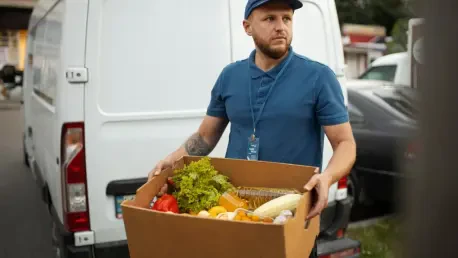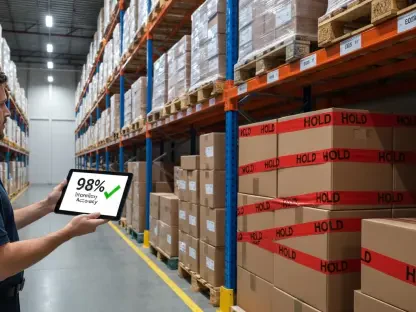Introduction to a Critical Challenge in Food Logistics
In the heart of a bustling economy, the U.S. food logistics sector faces an unprecedented hurdle as a government shutdown, now stretching into its third week in 2025, halts critical operations and data flows, sending shockwaves through an industry that underpins national food security. This funding lapse affects everything from perishable goods transport to regulatory compliance. With millions of tons of food moving daily through intricate supply chains, the shutdown’s impact on oversight and market forecasting raises pressing questions about resilience and adaptability in a vital sector.
The food logistics and cold chain industries serve as the backbone of the U.S. economy, ensuring that fresh produce, dairy, and meat reach consumers efficiently and safely. Valued at billions annually, this sector relies on a complex network of carriers, warehouses, and regulatory bodies to maintain standards and prevent disruptions. As the shutdown persists, the interplay between sustained essential services and suspended non-critical functions creates a unique challenge for stakeholders across the supply chain.
Current State of the U.S. Food Logistics Sector
The U.S. food logistics industry remains a cornerstone of economic stability, managing the transport and storage of perishable goods through advanced cold chain technologies. Major players, including national carriers and specialized warehouse operators, leverage innovations like real-time temperature monitoring and automated routing to enhance efficiency. The sector’s scope spans from farm to table, ensuring that supermarkets and restaurants stay stocked amid fluctuating demand.
Regulatory oversight plays a pivotal role in maintaining food safety and supply chain integrity. Agencies like the USDA and FDA set stringent standards for handling and inspection, safeguarding public health while supporting market confidence. However, with the current funding impasse, the industry’s reliance on federal coordination has become a double-edged sword, exposing vulnerabilities in planning and compliance.
Technological advancements continue to drive progress, with data analytics and IoT solutions improving inventory management and reducing waste. Yet, the absence of federal economic reports and capacity tracking during the shutdown limits the industry’s ability to anticipate market shifts, underscoring the need for robust contingency strategies in times of uncertainty.
Immediate Effects on Operations and Oversight
Continuation of Core Services
Despite the government shutdown, essential services within food logistics persist to prevent immediate crises. The USDA Food Safety and Inspection Service continues to inspect meat, poultry, and egg products, ensuring that safety standards are upheld at processing plants nationwide. Similarly, the FDA maintains oversight of high-risk food safety issues, prioritizing consumer protection amid reduced operations.
Freight processing by U.S. Customs and Border Protection remains active, facilitating the flow of imported goods critical to the supply chain. Additionally, sustained funding for the Federal Motor Carrier Safety Administration and Federal Highway Administration ensures that road transport operations face no immediate interruptions, providing a temporary buffer for carriers navigating the uncertainty.
This continuity of critical functions offers a lifeline to the industry, allowing key segments of the food supply chain to operate without catastrophic halts. Nevertheless, the strain on resources and personnel, many of whom work without pay, hints at potential cracks in this short-term stability.
Suspension of Secondary but Vital Functions
On the flip side, non-essential functions have ground to a halt, creating significant operational gaps. Routine FDA inspections and compliance reviews are delayed, leaving food processing and storage facilities in limbo as they await regulatory clearance. This pause introduces uncertainty, particularly for businesses reliant on timely approvals to maintain market access.
Critical data reporting also suffers, with USDA crop reports, World Agricultural Supply and Demand Estimates, and trade data from the Foreign Agricultural Service unavailable. The absence of federal economic data from agencies like the Bureau of Labor Statistics further clouds demand forecasting, hampering strategic planning for supply chain managers.
Cold chain capacity tracking, typically provided by USDA resources, is another casualty, limiting visibility into storage availability and transport logistics. These disruptions collectively undermine the industry’s ability to respond proactively to market needs, setting the stage for broader challenges if the shutdown drags on.
Ripple Effects Across the Food Supply Chain
The operational uncertainties stemming from delayed inspections weigh heavily on food processing and storage facilities, which must navigate compliance risks without clear guidance. This lack of oversight could lead to bottlenecks, as products await clearance, potentially disrupting delivery schedules and increasing spoilage risks for perishable items.
Smaller carriers and warehouse operators face additional financial strain due to the halt in Small Business Administration lending programs. Without access to credit, these businesses may struggle to cover operational costs or invest in necessary equipment upgrades, exacerbating existing economic pressures.
To mitigate these challenges, some companies are exploring private financing options or partnering with larger firms for temporary support. Others are adjusting inventory levels to minimize exposure to delays, though such measures often come at the cost of reduced efficiency and higher expenses, highlighting the need for systemic solutions.
Regulatory and Financial Disruptions in Focus
Beyond immediate logistics, the shutdown’s suspension of regulatory functions threatens broader stability in the food sector. State-level food safety programs, often dependent on federal reimbursements, face budget constraints that could weaken local oversight and increase risks of contamination or recalls over time.
Funding interruptions for nutrition programs like the Supplemental Nutrition Assistance Program and the Women, Infants, and Children initiative loom as a potential concern by late 2025. Such disruptions could dampen grocery sales, particularly for staple foods, while affecting consumer markets and retailer revenues in communities reliant on these benefits.
The cascading impact of these financial and regulatory gaps extends to market confidence, as stakeholders grapple with reduced visibility into policy and funding landscapes. This uncertainty underscores the interconnected nature of federal support in sustaining both supply chain operations and consumer access to food.
Long-Term Outlook Amid Persistent Shutdown Risks
If the shutdown extends further, disruptions in food logistics and trade flows are likely to intensify, with air cargo delays for perishables emerging as a critical issue due to absenteeism among unpaid air traffic controllers. Such delays could lead to significant losses for exporters and importers of time-sensitive goods like fresh produce and seafood.
Consumer confidence may also erode, particularly in foodservice and travel sectors, as furloughed federal workers reduce discretionary spending. Combined with the ongoing lack of economic data, this decline could obscure inventory management and supply chain planning, creating a feedback loop of uncertainty for businesses.
Looking ahead, budget negotiations in Congress are expected to gain urgency by late 2025, with added pressure from the mid-November Treasury debt management deadline. A temporary funding measure, often termed a continuing resolution, appears likely to restore operations in the near term, though prolonged delays could deepen the industry’s challenges and test its adaptability.
Reflecting on Impacts and Charting a Path Forward
Looking back, the government shutdown cast a complex shadow over the U.S. food logistics sector, balancing the resilience of essential services against the disruptive force of suspended non-essential functions. The persistence of safety inspections and transport operations provided a critical buffer, yet the absence of routine oversight and data releases strained planning and compliance efforts across the supply chain.
As a next step, industry stakeholders should prioritize contingency planning, leveraging private sector partnerships and alternative data sources to bridge gaps in federal support. Advocating for swift congressional resolution remains essential to restore full regulatory and financial backing, particularly for vulnerable nutrition programs and small businesses.
Additionally, investing in technology to enhance supply chain visibility and resilience could offer a long-term safeguard against similar disruptions. By focusing on these actionable strategies, the food logistics industry can better prepare for uncertainties, ensuring stability for producers, retailers, and consumers alike in the face of future challenges.









